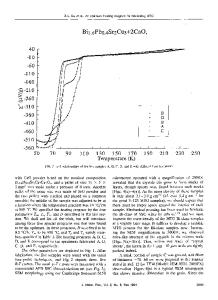Ternary Cu 3 Bi Y 3 ( Y = S, Se, and Te) for Thin-Film Solar Cells
- PDF / 489,417 Bytes
- 6 Pages / 432 x 648 pts Page_size
- 55 Downloads / 373 Views
Ternary Cu3BiY3 (Y = S, Se, and Te) for Thin-Film Solar Cells Mukesh Kumar1 and Clas Persson1,2 1 Department of Materials Science and Engineering, Royal Institute of Technology, SE-100 44 Stockholm, Sweden. 2 Department of Physics, University of Oslo, P.O. Box 1048 Blindern, NO-0316 Oslo, Norway. ABSTRACT Very recently, Cu3BiS3 has been suggested as an alternative material for photovoltaic (PV) thinfilm technologies. In this work, we analyze the electronic and optical properties of Cu3BiY3 with the anion elements Y = S, Se, and Te, employing a first-principles approach within the density function theory. We find that the three Cu3BiY3 compounds have indirect band gaps and the gap energies are in the region of 1.2–1.7 eV. The energy dispersions of the lowest conduction bands are small, and therefore the direct gap energies are only ~0.1 eV larger than the fundamental gap energies. The flat conduction bands are explained by the presence of localized Bi p-states in the band gap region. Flat energy dispersion implies a large optical absorption, and the calculations reveal that the absorption coefficient of Cu3BiY3 is larger than 105 cm−1 for photon energies of ~2.5 eV. The absorption is stronger than other Cu-S based materials like CuInS2 and Cu2ZnSnS4. Thereby, Cu3BiY3 has the potential to be a suitable material in thin-film PV technologies. INTRODUCTION Development of photovoltaic materials (PV) that involves only inexpensive, non-toxic, and earth abundant elements is considered to be a major criterion to meet the increasing demand for electricity production [1]. For that reason, Cu(In,Ga)Se2 [2,3], CdTe [4,5], and Cu2ZnSn(S,Se)4 [6,7] compounds are utilized in thin-film PV technologies. However, due to cost issues (In, Ga), supply issues (In, Te), and environmental issues (Cd), also these solar cell materials are discussed to be replaced in future clean-electricity technologies. That is, thin-film PV devices based on these ternary copper-based chalcogenides may not has reached its optimum device level, and therefore research work are dedicate to improve the quality of the thin-films as well as to find alternative solutions. For example, Cu3BiS3 has been suggested as an alternative material for thin-film PV cells [8-13]. It has been reported that Cu3BiS3 prepared by sulfurization of BiCu metal precursors can achieve an external quantum efficiency of 10% [9]. Even though Bi is not an optimal element, its content ratio is only 1/7 in this compound. In order to explore these alternative PV materials, it is important to carefully study and analyze the fundamental physical properties of the compounds. In this work, we study the electronic structure and the optical activity of Cu3BiY3 (with Y = S, Se, and Te). For comparison, we present calculations also of Cu3SbS3. We used the projector augmented wave method within the density functional theory (DFT) and in conjunction with a screened hybrid functional [8,14-17]. We find that all three compounds of Cu3BiY3 as well as Cu3SbS3 are indirect band gap semiconductors. The fundam
Data Loading...










